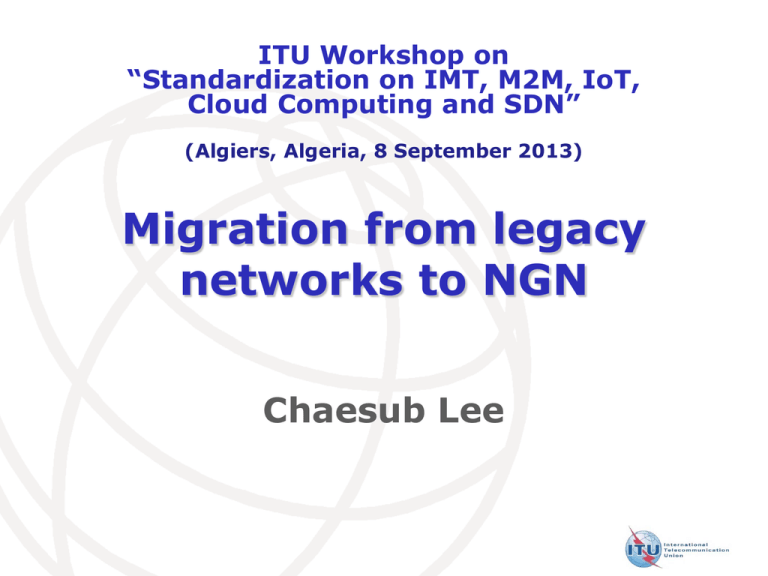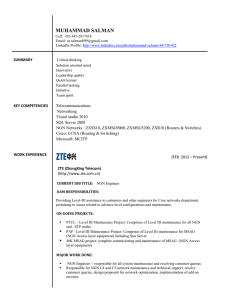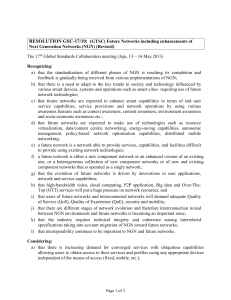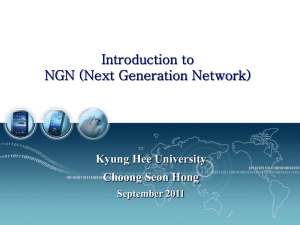Migration from legacy networks to NGN Chaesub Lee ITU Workshop on
advertisement

ITU Workshop on “Standardization on IMT, M2M, IoT, Cloud Computing and SDN” (Algiers, Algeria, 8 September 2013) Migration from legacy networks to NGN Chaesub Lee Contents 1. Legacy Networks (LNs) 2. Summary of NGN 3. Gaps 4. For Migration 5. Conclusion 2 1. Legacy Networks (LNs) Definition and scope of LNs Definition of LNs (Not formal): a network based on older, out-dated protocol that is not based on the IP (TCP/IP) protocol. IPX, SNA, AppleTalk and DECnet are examples of legacy networks. Scope of LNs: • Public Switched Telephone Networks (PSTN) • Packet Switched Data Networks (PSDN) • Integrated Services Digital Networks (ISDN) 3 1. Legacy Networks (LNs) PSTN Features of PSTN: • the oldest and widest popular network • voice-band services (voice and 3.1 kHz Audio-band data services) • the channel remains reserved and not allow to use for competing users (full dedicated) • provides continuous transfer without the overhead • a dedicated path persisting between two communicating parties or nodes • the constant bit delay during a connection • guaranteed a QoS of the circuit (channel), so no degradation of QoS by competing users 4 1. Legacy Networks (LNs) PSTN Architectures and Configurations of PSTN Local Switch Toll Networks 3 Local Switch Tandem Networks Toll Switch Local Switch 4 4 1 Local Switch Local networks Tandem Switch 2 5 International Gateway Satellite International Cable (Optic, submarine) 5 1. Legacy Networks (LNs) Features of PSDN: PSDN • Packet means a small container or a pouch, such as a formatted block of data • Physical layer: specifies the physical, electrical, functional and procedural characteristics to control the physical link between a DTE and a DCE (e.g. X.21) • Data link layer: link access procedure for data interchange on the link between a DTE and a DCE (LAPB) that manages a communication session and controls the packet framing including error correction & orderly delivery • Packet layer: exchanging control and user data packets to form a packet-switching network 6 1. Legacy Networks (LNs) ISDN Features of ISDN: • Circuit switching: Provide 64 kb/s including bigger than 64 kb/s (rate adapted to 64 kb/s for less than 64 kb/s rate) • Packet switching: Provide number of packet mode bearer services based on two types; packet handling functions: handling of packet calls within the ISDN; interworking functions: interworking between ISDN and PSDN; • Frame mode: Provide the order preserving bidirectional transfer of service data units (L2 frames) on the basis of an attached label • Signalling capability: carried by the Dchannel 7 1. Legacy Networks (LNs) ISDN Functional architecture of ISDN Broad -band Leased Line PSTN PSDN 8 1. Legacy Networks (LNs) ISDN Functional configuration of ISDN 9 2. Summary of NGN Definition of NGN ITU-T Rec. Y.2001 Next Generation Network (NGN): a packet-based network able to provide telecommunication services and able to make use of multiple broadband, QoSenabled transport technologies and in which service-related functions are independent from underlying transport-related technologies. It enables unfettered access for users to networks and to competing service providers and/or services of their choice. It supports generalized mobility which will allow consistent and ubiquitous provision of services to users. 2. Summary of NGN Practical meaning of NGN NGN is a Broadband Managed IP-based Network • NGN got benefits from today’s broadband capabilities; over fixed, over mobile and over wireless • NGN has capabilities to support managed features of IP based network, especially QoS, Security and Mobility Best Effort IP Limited BW N G N Managed IP (Quality, Security, Mobility) Broadband: Fixed, Mobile, Wireless 2. Summary of NGN Summary features of NGN Packet-based transfer; Separation of control functions; Decoupling of service provision from transport; Support for a wide range of services based on service building blocks; Broadband capabilities with end-to-end QoS; Interworking with legacy networks via open interfaces; Generalized mobility; Unfettered access by users to different service providers; A variety of identification schemes; Converged services between fixed/mobile; Support of multiple last mile technologies; Compliant with all regulatory requirements (e.g. emergency, privacy, lawful interception, etc.) 2. Summary of NGN Capability requirements of NGN (1) Transport connectivity Use of IPv4 and Ipv6; real time and non-real time comm. One-to-one and one-to-many connectivity Communication modes One-to-one, one-to-many; Many-to-any, many-to-one Media resources management Support various media resources and its managements; Media recording, DTMF/advanced speech recognition, media conversion, transcoding, bridging, duplication and insertion Codecs Transcoding should be avoided wherever possible; Shall support end-end codec negotiation; Supporting G.711 for interworking with other networks 2. Summary of NGN Capability requirements of NGN (2) Access network and network attachment Shall support diverse access transport technologies; Capable of providing IP connectivity; Support registration & re-config. at the access network; User access authen. data/inf. in user profile used for access configuration User networks support access to the NGN via a user network with NAT/NAPT/Firewalls; simultaneous use of multiple types of access transport functions by a single terminal Interconnection and Interworking Connectivity-oriented and service-oriented interconnection; support interworking with PSTN/ISDN and other networks 2. Summary of NGN NGN Basic Reference Model Separation Transport (Access and Core) from Services But keeping 3 Planes for basic function: User, Control and Management Management Plane Control Plane User Plane NGN Service Layer Management Plane Control Plane User Plane NGN Transport Layer 2. Summary of NGN Overall NGN Architecture Applications ANI SNI Application Support Functions and Service Support Functions IdM Functions Service Control and Content Delivery Functions Management Functions Service User Profiles Service Control Functions Functions from other Service Providers Content Delivery Functions Service Stratum Network Attachment and Control Functions Transport User Profiles Mobility Management and Control Functions Resource and Admission control Functions Functions from Other Networks Transport Control Functions End-User Functions Transport Functions UNI Y.2291 NNI Transport Stratum Control Media Management IdM 3. Gaps Technical Gaps between NGN and LNs Legacy Networks Service Switching PSTN PSDN internet Voice & Voiceband Data (telephony) (Non Real-time) Data Information Circuit Packet Packet (X.25) (IP) PDH (SDH) PDH (SDH) PDH (SDH) Narrowband (Copper) Narrowband (Copper) Narrow and Broadband (64kbit Channel) Transmission Medium Technical Gaps PSTN PSDN internet Voice & Voiceband Data (telephony) Data (Non Real-time) Information Circuit Packet Packet (64kbit Channel) (X.25) (IP) NGN Integrated Multimedia Services (real/non real-time) IP QoS/Security Packet adaptation/Addressing/Accounting PAD/Numbering/Accounting & charging/Echo Cancellation 3. Gaps Gaps on Architectural aspects Vertical views Single-layered TRANSIT NETWORK NATIONAL/REGIONAL NGN Horizontal views LAYER LEX/GW LAYER RU LAYER 4. For Migration PSTN/ISDN Emulation & Simulation Emulation: Provision of PSTN/ISDN service capabilities and interfaces using adaptation to an IP infrastructure An encapsulation process All services available to PSTN/ISDN users User experience not changed UNI UNI ADF2 User equipment * ADF: Adaptation Function NGN ADF2 User equipment 4. For Migration PSTN/ISDN Emulation & Simulation Simulation: Provision of PSTN/ISDN-like service capabilities using session control over IP PSTN/ISDN-like services available Availability of possible new services User experience is changed by the network transformation UNI UNI NGN User equipment User equipment UNI ADF1 Legacy User equipment 4. For Migration Overall Configuration Simulation NGN (Carrier Y) PLMN User equipment User equipment NNI IWF UNI UNI ADF1 NGN (Carrier X) UNI User equipment ADF1 ADF2 ADF2 UNI IWF IWF User equipment NNI PSTN/ISDN Public IP Network, e.g. SIP (non-IMS) User equipment UNI = User Network Interface = IF1 NNI = Network Node Interface = IF2 User equipment Emulation ADF= Adaptation Function IWF=Interworking Function 4. For Migration Overlay Migration Scenario deploy NGN overlay to the existing LNs two infrastructures both NGN and LNs exist together NGN provides advanced services while LNs keep existing services Overlay NGN network ADF NGNNGN expansion NGN NGN ADF ADF IWF Legacy Networks shrink Legacy Networks 4. For Migration Replacement Migration Scenario Use mixed simulation and emulation together Simulation: for PSTN/ISDN-like services to the NGN users with advanced NGN features Emulation: for voice oriented services keeping the legacy terminal Overlay NGN network NGN Core ADF ADF NGN-A (Simul.) ADF IWF NGN-A Legacy Replace (Emul.) Networks Legacy Core Replace LegacyAccess LegacyAccess LegacyAccess LegacyAccess 5. Conclusion Handbook on “Migration Scenarios from Legacy Networks to NGN in developing countries” has been approved at the February 2013 SG13 meeting Thank you for your attention !!!





